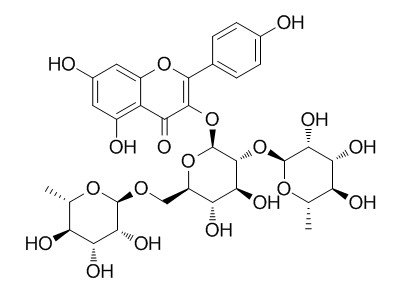Clitorin
Clitorin has free radical scavenging property. It shows significant interactions with CD38, it may have anti-hyperglycemic potential.
Inquire / Order:
manager@chemfaces.com
Technical Inquiries:
service@chemfaces.com
Tel:
+86-27-84237783
Fax:
+86-27-84254680
Address:
1 Building, No. 83, CheCheng Rd., Wuhan Economic and Technological Development Zone, Wuhan, Hubei 430056, PRC
Providing storage is as stated on the product vial and the vial is kept tightly sealed, the product can be stored for up to
24 months(2-8C).
Wherever possible, you should prepare and use solutions on the same day. However, if you need to make up stock solutions in advance, we recommend that you store the solution as aliquots in tightly sealed vials at -20C. Generally, these will be useable for up to two weeks. Before use, and prior to opening the vial we recommend that you allow your product to equilibrate to room temperature for at least 1 hour.
Need more advice on solubility, usage and handling? Please email to: service@chemfaces.com
The packaging of the product may have turned upside down during transportation, resulting in the natural compounds adhering to the neck or cap of the vial. take the vial out of its packaging and gently shake to let the compounds fall to the bottom of the vial. for liquid products, centrifuge at 200-500 RPM to gather the liquid at the bottom of the vial. try to avoid loss or contamination during handling.
J Colloid Interface Sci.2024, 662:760-773.
Anticancer Res.2014, 34(7):3505-9
PLoS One.2022, 17(6):e0268505.
Journal of Ginseng Research2019, 10.1016
Journal of Medicinal Food2023, Vol.26(10).
Phytomedicine.2020, 79, 153351
Pak J Pharm Sci.2018, 31:311-315
Eur J Ther.2023, 29(4):900-906.
Cancer Lett. 2023, 18:216584.
Universitat Stuttgart2022, opus-12200.
Related and Featured Products
J Ethnopharmacol. 2014 Aug 8;155(1):426-34.
HPLC-based activity profiling for antiplasmodial compounds in the traditional Indonesian medicinal plant Carica papaya L.[Pubmed:
24892830 ]
Leaf decoctions of Carica papaya have been traditionally used in some parts of Indonesia to treat and prevent malaria. Leaf extracts and fraction have been previously shown to possess antiplasmodial activity in vitro and in vivo.
METHODS AND RESULTS:
Antiplasmodial activity of extracts was confirmed and the active fractions in the extract were identified by HPLC-based activity profiling, a gradient HPLC fractionation of a single injection of the extract, followed by offline bioassay of the obtained microfractions. For preparative isolation of compounds, an alkaloidal fraction was obtained via adsorption on cationic ion exchange resin. Active compounds were purified by HPLC-MS and MPLC-ELSD. Structures were established by HR-ESI-MS and NMR spectroscopy. For compounds 5 and 7 absolute configuration was confirmed by comparison of experimental and calculated electronic circular dichroism (ECD) spectroscopy data, and by X-ray crystallography. Compounds were tested for bioactivity in vitro against four parasites (Trypanosoma brucei rhodesiense, Trypanosoma cruzi, Leishmania donovani, and Plasmodium falciparum), and in the Plasmodium berghei mouse model. Profiling indicated flavonoids and alkaloids in the active time windows. A total of nine compounds were isolated. Four were known flavonols--manghaslin, Clitorin, rutin, and nicotiflorin. Five compounds isolated from the alkaloidal fraction were piperidine alkaloids. Compounds 5 and 6 were inactive carpamic acid and methyl carpamate, while three alkaloids 7-9 showed high antiplasmodial activity and low cytotoxicity. When tested in the Plasmodium berghei mouse model, carpaine (7) did not increase the survival time of animals.
CONCLUSIONS:
The antiplasmodial activity of papaya leaves could be linked to alkaloids. Among these, carpaine was highly active and selective in vitro. The high in vitro activity could not be substantiated with the in vivo murine model. Further investigations are needed to clarify the divergence between our negative in vivo results for carpaine, and previous reports of in vivo activity with papaya leaf extracts.
Journal of Food Biochemistry, 2015,39(6):642–652.
In Vivo Anti-Hyperglycemic Potential of Brahmi Gritham and Docking Studies of Its Active Components Against Protein Kinase C and CD38[Reference:
WebLink]
The anti-hyperglycemic and antioxidant effects of the Indian herbal formulation Brahmi gritham were studied in streptozotocin-induced diabetic female Wistar albino rats.
METHODS AND RESULTS:
Diabetes was induced by a single dose of streptozotocin (55 mg/kg body weight [b.w.], i.p.). Estimation of blood glucose levels, liver glycogen content and antioxidant levels were carried out in experimental rats. The tested parameters were compared with those of the glibenclamide (600 μg/kg b.w.) treated group. Molecular docking studies were carried out to analyze the interaction patterns of protein kinase C (PKC) and CD38 of chosen proteins of signal transduction pathways that are significant in the pathogenesis of diabetes against active components of Brahmi gritham. Immunohistochemistry of pancreas revealed that Brahmi gritham was able to restore β-cell mass and function near to that of the normal control. In silico studies showed that apigenin and quercetin showed significant interactions with PKC, while Clitorin, bacopaside I and II showed significant interactions with CD38. Quercetin showed highest percentage inhibition of α-amylase enzyme.Practical ApplicationsBrahmi gritham is a traditional polyherbal formulation used in Ayurveda to treat memory disorders.
The individual components of this formulation are known to possess significant antioxidant properties and contain several biologically active compounds found to be effective in treating various disorders, including diabetes and obesity.
CONCLUSIONS:
The efficacy of Brahmi gritham in diabetes management has not yet been studied, and therefore, the present study provides insights into the anti-hyperglycemic potential of this formulation in rat model. In addition, the results of in silico analysis would pave way for better utilization of the flavonoids quercetin and apigenin in diabetes management and in particular microvascular diabetic complications.
Pharm Biol. 2000;38(3):222-8.
New phenolic radical scavengers from saxifraga cuneifolia.[Pubmed:
21214466]
Thirteen compounds have been isolated from the methanol extract of Saxifraga cuneifolia L. (Saxifragaceae) whole plant.
METHODS AND RESULTS:
These were identified as five new compounds, (E)-5-O-ß-D-glucopyranosyl-stilbene-3,3', 4,5'-tetraol, (E)-4-O-ß-D-glucopyranosyl-5-methoxy-stilbene-3,3',5'-triol, 4-[4'-O-(6''-O-galloyl-ß-D-glucopyranosyl)-3'-hydroxyphenyl]butan-2-one, 3-O-(6''-O-galloyl-ß-D-glucopyranosyl)-epigallocatechin and 3-O-ß-D-glucopyranosyl-epigallocatechin, together with the known compounds 4-[4'-O-ß-D-glucopyranosyl-3'-hydroxyphenyl]-butan-2-one, (R)-rhododendrin, 1-O-galloyl-ß-D-glucose, catechin, 3-O-galloyl-epigallocatechin, gallocatechin, Clitorin and rutin, by chemical and spectroscopic methods. Their free radical scavenging properties are also described.



